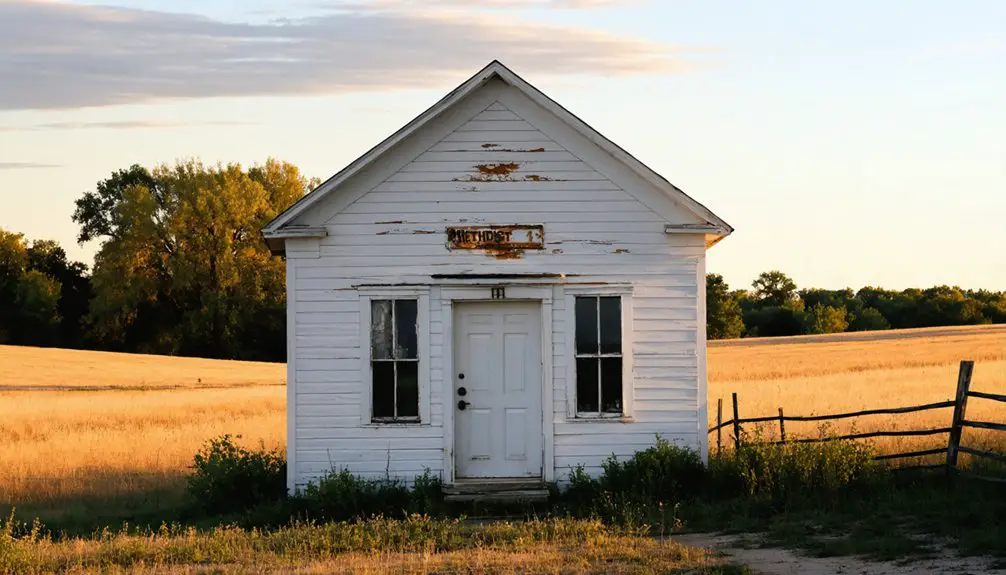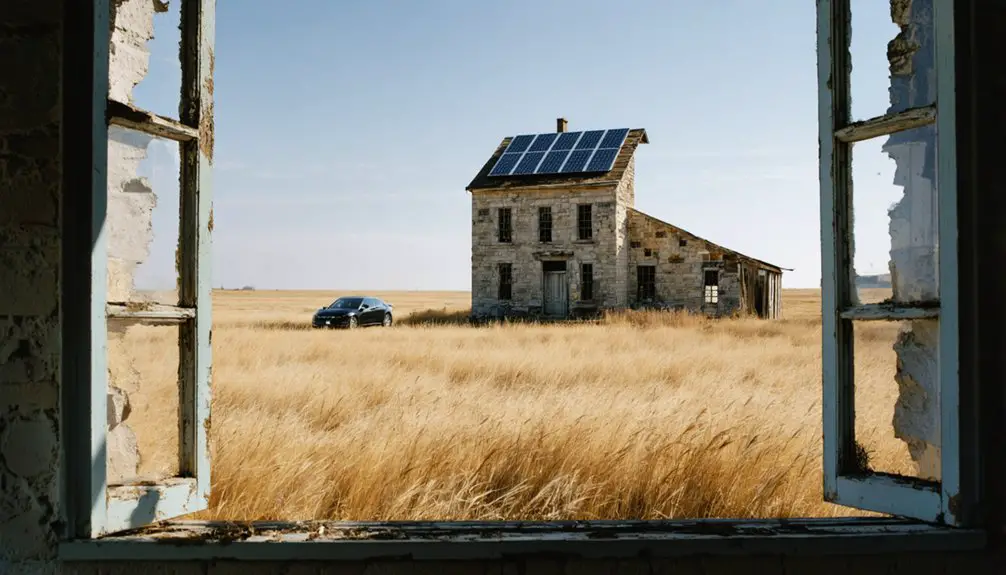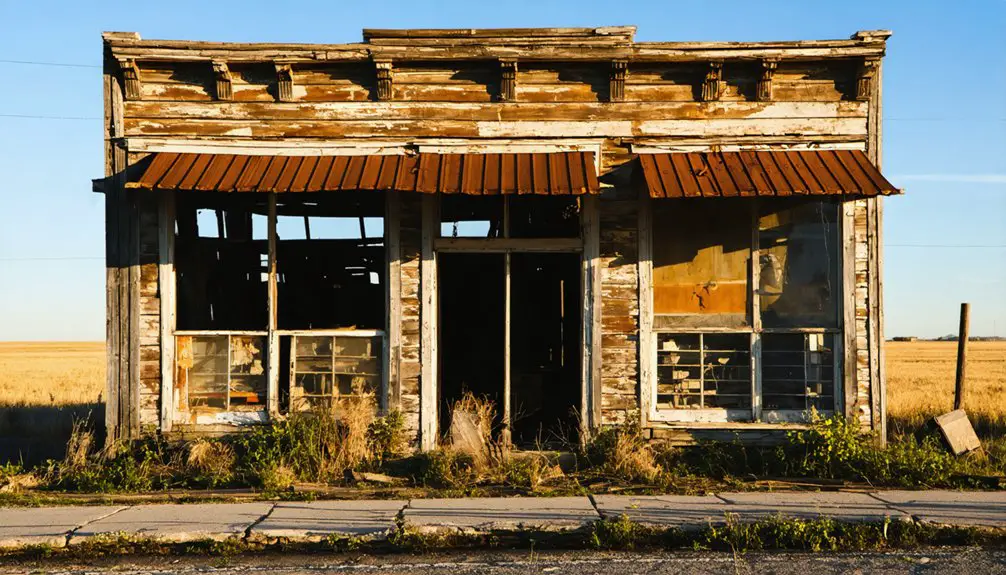You’ll find Castleton, Kansas nestled along the historic Santa Fe Railway line in Reno County. This once-thriving railroad town, established in 1869, served as a crucial agricultural hub until the mid-20th century. In 1952, it gained Hollywood fame when Twentieth Century-Fox filmed “Wait Till the Sun Shines, Nellie” there. While its post office closed in 1957 and schools consolidated by 1970, Castleton’s historic buildings and rich frontier legacy hold countless stories of Kansas’s railway era.
Key Takeaways
- Castleton, Kansas evolved from a bustling railway town established in 1869 to a ghost town following agricultural mechanization and population decline.
- The closure of the post office in 1957 and local schools in 1954 and 1970 marked significant milestones in Castleton’s transformation.
- The town gained Hollywood recognition when “Wait Till the Sun Shines, Nellie” was filmed there in 1952 using its period architecture.
- Originally thriving through railway transport and agriculture, Castleton now features abandoned buildings and quiet streets reflecting its ghost town status.
- Preservation efforts are ongoing to document Castleton’s frontier history, with the town being considered for the National Register of Historic Places.
A Railway Town’s Birth Along the Santa Fe Line
While the Kansas Territorial Legislature chartered the Atchison and Topeka Railroad in 1859, construction delays from the devastating 1860 drought and Civil War meant Castleton wouldn’t emerge until after rail crews finally began laying track westward in 1869.
You’ll find Castleton’s railway significance deeply rooted in the Santa Fe line’s strategic expansion through Kansas. The town sprang up as one of many essential service points established along the route, which reached Emporia by 1870 and pushed toward Wichita and Newton by 1872. The railroad’s name changed to Santa Fe Railway in 1863, reflecting its ambitious expansion goals. The first diesel locomotive appeared on the line in February 1935, marking a major technological advancement.
Like other railway-born settlements, Castleton’s location proved ideal for both train operations and agricultural impact. The town served as a critical link between regional farmers and national markets, while its station facilitated the movement of wheat crops and cattle to eastern destinations.
From Bustling Station to Quiet Streets
The gradual erosion of Castleton’s significance began in earnest as agricultural mechanization transformed Kansas farming practices.
As machines replaced farmhands across Kansas fields, Castleton’s vital role in the agricultural community slowly slipped away.
You’ll find that as farms grew larger and required fewer workers, the town’s population decline accelerated. The once-bustling railway station fell silent as economic shifts drew both commerce and residents toward larger neighboring cities.
Where you once would’ve seen thriving businesses and busy streets, you’ll now discover abandoned buildings and quiet lanes.
The transformation from crucial transportation hub to near-ghost town status reflects a pattern common to Kansas communities bypassed by changing transportation networks.
While a few determined residents remain in the area, Castleton’s commercial heart has stopped beating. The town became a unique piece of history as the setting for Wait Till Sun Shines.
Beautiful farmland surrounds the quiet streets, drawing occasional visitors to the area.
The empty storefronts and deteriorating structures tell the story of a town that couldn’t survive the profound changes in rural American life.
Hollywood Comes to Town: The 1952 Film Production
In 1952, Hollywood descended upon Castleton when Twentieth Century-Fox chose the small Kansas town as a filming location for *Wait Till the Sun Shines, Nellie*. The film, starring Jean Peters and David Wayne, transformed the quiet streets into a bustling movie set. The film’s themes explored the story of a barbershop owner’s struggles with his wife Nellie’s desire for a bigger life beyond small-town living. That same year, filmmakers were busy across Kansas, as Santa Catalina Island served as a key location for the crime drama Kansas City Confidential.
You’ll find that Castleton’s authentic period architecture and small-town atmosphere made it an ideal backdrop for the story, which was based on Ferdinand Reyher’s novel *I Heard Them Sing*.
The production, which also utilized nearby Hutchinson for filming and the movie’s premiere, brought unprecedented attention to the region.
The film locations preserved a visual record of Castleton’s historical significance, documenting the town’s mid-century appearance.
Today, this Hollywood connection remains a proud chapter in Castleton’s history, marking a time when this Kansas ghost town briefly recaptured its former liveliness.
Educational Heritage and School Consolidation
If you’d explored Castleton’s school system in the mid-20th century, you’d have found the Pirates competing in their red and blue colors until Castleton High School’s closure in 1954.
The educational landscape shifted dramatically when Castleton Grade School followed suit in 1970, with students transferring to Pretty Prairie USD 311.
These closures, part of Kansas’s broader school consolidation movement, marked a significant change for the community as it moved toward ghost town status.
The area’s education history traced back to early developments when the county had 116 teachers employed by 1880, showing the robust school system that once existed across Reno County.
The town’s educational roots began when the Harmony Baptist Church organized in 1875, providing one of the first gathering places for community and learning activities.
School Closures Timeline
During the mid-20th century, Castleton’s educational landscape underwent dramatic changes as rural schools gradually closed their doors amid widespread population decline.
You’ll find that these closures, driven by state mandates and financial pressures, transformed the area’s school nostalgia and community dynamics forever. The consolidation movement gained momentum throughout the 1950s-1970s, as improved transportation allowed students to travel further to larger, centralized facilities. School officials would make closure decisions by 10 pm broadcasts whenever possible to give families adequate notice.
One by one, the cherished one-room schoolhouses that had served generations of local families shuttered their operations. Weather conditions played a crucial role in daily operations, with administrators carefully monitoring road and travel conditions before making closure decisions.
Educational District Changes
While Kansas broadly defined school consolidation as merging attendance areas, Castleton’s educational landscape underwent more complex changes through “unification” under House Bill 377 in the 1960s.
You’ll find that these educational trends mirrored the region’s evolving needs, as Reno County’s original 1870s district formations gave way to modern reorganization.
The community impact became evident when Castleton High School closed in 1954, followed by the grade school’s closure in 1970.
Students then transferred to Pretty Prairie USD 311, marking a significant shift in local education.
Though the Pirates’ red and blue colors faded from active use, they’ve remained powerful symbols of Castleton’s educational heritage.
This transformation reflected wider patterns of rural school consolidation that reshaped Kansas’s educational framework during the mid-20th century.
Pirates Athletic Legacy
The Castleton Pirates’ athletic legacy stands as a cherished chapter in the town’s history, with red and blue colors representing more than just school spirit. You’ll find this pirates pride deeply woven into the community’s identity, particularly through figures like Larry Foss, who went on to play for both the Pittsburgh Pirates and New York Mets.
Before the school’s closure in 1954, athletic resilience defined Castleton High School‘s presence in Reno County. Located northeast of Pretty Prairie, the school’s athletic programs united the community, creating lasting bonds that transcended the playing field.
Though consolidation eventually claimed the school, the Pirates’ impact on local culture hasn’t faded. The mascot’s symbolism of strength and determination continues to represent an era when athletics helped shape this Kansas railway town’s character.
The Post Office: Heart of the Community
From its establishment on December 6, 1872, Castleton’s post office served as more than just a mail distribution center – it became the beating heart of this Kansas railway town.
Under the initial leadership of postmaster Wm. Wallace, the office fostered essential community connections through its 85-year run, linking residents to the wider world via railway postal routes.
You’ll find the post office’s postal significance extended beyond mail handling – it was where townspeople gathered to exchange news and conduct business.
The building’s preservation at the Barton County Historical Society Museum and Village, following its 1971 relocation, stands as a reflection of its central role in rural life.
When the office closed on June 28, 1957, it marked a pivotal moment in Castleton’s story, signaling the community’s gradual shift toward ghost town status.
Notable Names and Local Legends

Among Castleton’s most notable residents, you’ll find Larry Foss, who pitched in Major League Baseball for both the Pittsburgh Pirates and New York Mets.
When Hollywood came calling in 1952, local residents appeared as extras in the film “Wait Till the Sun Shines, Nellie,” where Castleton stood in for the fictional town of Sevillinois, Illinois.
The town’s brush with fame didn’t end with baseball and movies, as you’ll discover in the notorious connection between local figures and the infamous outlaws Bonnie Parker and Clyde Barrow.
Larry Foss Baseball Career
Born in Castleton, Kansas in 1936, Larry Foss emerged as one of the town’s most notable sports figures through his brief but meaningful Major League Baseball career.
After playing college baseball at Wichita State University, he signed with the Pittsburgh Pirates in 1955. Foss’s impact reached its peak when he made his MLB debut in 1961, ultimately appearing in eight games between the Pirates and New York Mets.
While his career statistics – including a 5.33 ERA and 1-2 record – might seem modest, they represent local sportsmanship at its finest. He pitched 27 innings in the majors before returning to minor league baseball, where he played until 1963.
As one of the few MLB players from Castleton, his legacy continues to inspire this small Kansas community.
Local Movie Star Extras
Castleton’s most significant brush with Hollywood came in 1951 when the film “Wait Till the Sun Shines, Nellie” transformed this small Kansas town into the fictional Sevillinois, Illinois of 1905.
Local involvement became a cornerstone of the production, with residents stepping in as extras while local seamstresses, including Francie White Grilliot’s mother, created period-authentic costumes.
- The town’s children and adults donned vintage wardrobe pieces stored at the high school
- Local seamstresses contributed their skills for costume creation
- The post office and Santa Fe depot served as anchors for the period sets
- While the film brought temporary excitement, it didn’t launch any major Hollywood careers from Castleton
Despite the brief cinematic spotlight, this singular movie experience remains a treasured memory of the town’s final flourishing years before its decline.
Preserving Castleton’s Physical Legacy
While time has taken its toll on the physical remnants of this once-bustling mining supply town, several key structures and foundations from Castleton’s heyday still dot the Kansas landscape.
You’ll find traces of the town’s cultural significance in the weathered ruins of hotels, livery stables, and the old post office that served the community until 1957.
Today, restoration challenges include battling sand infiltration and harsh weather that continually threaten these historic structures. The Bureau of Land Management‘s funded research aims to stabilize what remains, while preservation groups work to document the site’s rich history.
If you’re interested in exploring this piece of Kansas heritage, you’ll discover a candidate for the National Register of Historic Places that tells the story of 1880s frontier life.
Life in Modern-Day Castleton

The quiet streets of modern-day Castleton stand in stark contrast to its historic past. While you won’t find the bustling railway activity that once defined this unincorporated Reno County community, you’ll discover a place that embodies rural Kansas living northeast of Pretty Prairie.
Today’s Castleton offers:
- Access to essential services through nearby communities, including education through Pretty Prairie USD 311
- Affordable real estate opportunities for those seeking economic revitalization projects
- A secluded lifestyle away from urban congestion, with Hutchinson’s amenities within driving distance
- Historic buildings that showcase potential for community engagement and entrepreneurial ventures
Despite limited infrastructure and job opportunities, you’ll find a community that represents both the challenges and freedoms of small-town prairie life, where residents maintain connections to larger towns while preserving their independence.
Frequently Asked Questions
What Native American Tribes Originally Inhabited the Castleton Area?
You’ll find the Kanza, Osage, Pawnee, and Comanche tribes dominated this area’s tribal history, with the Kaw and Sac/Fox tribes later camping near Arkansas River, leaving lasting cultural impact.
How Many People Lived in Castleton During Its Peak Population Years?
You’ll find that during its peak population years in the late 1800s, this railway stop likely housed between 100-300 residents, though historical records don’t provide exact numbers for this settlement.
Were There Any Major Natural Disasters That Affected Castleton’s Development?
Like a peaceful oasis untouched by storms, you won’t find any records of major natural disasters impacting Castleton. Neither flood impacts nor drought effects played a significant role in the town’s development or decline.
What Businesses and Stores Operated in Castleton Besides the Post Office?
You’d find a small grocery store where locals bought provisions and a blacksmith shop that served farmers’ metalworking needs, though records don’t confirm many other specific businesses in Castleton.
Did Castleton Have Any Churches or Religious Institutions During Its Existence?
You’ll find limited records of church history in Castleton, though there was a community church where religious services were held. Unfortunately, specific details about its denomination and operations aren’t well documented.
References
- https://legendsofkansas.com/kansas-ghost-town-list/
- http://kansasghosttowns.blogspot.com/2010/12/castleton-ks.html
- https://www.youtube.com/watch?v=Td_gmiDMfI4
- https://www.youtube.com/watch?v=cApROIIoTuY
- https://en.wikipedia.org/wiki/Castleton
- https://www.trains.com/ctr/railroads/fallen-flags/remembering-the-santa-fe-railway/
- https://tscpl.org/articles/remembering-santa-fe-railway
- https://www.tshaonline.org/handbook/entries/atchison-topeka-and-santa-fe-railway-system
- https://www.youtube.com/watch?v=r_QeinA4Q0I
- https://www.tshaonline.org/handbook/entries/panhandle-and-santa-fe-railway



